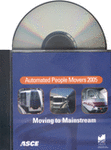Integrating Three-Dimensional Elevator Systems
Publication: Automated People Movers 2005: Moving to Mainstream
Abstract
Otis Elevator Company created and developed a prototype for an elevator that can move passengers in the same cab both horizontally and vertically as well as inside and outside. This dimensional concept was envisioned in order to allow the sky-scraper such as the Mile High City designed by Frank Lloyd Wright, originally limited by vertical movement, to become a reality. Now that a prototype exists and the technology has been tested by the Disney Corporation for their Tower of Terror, the physical possibility for this technology transfer to the "real world" is quite real. New transportation stations, downtowns, and mega-centers can be dramatically impacted by this new technology taking us into the 21st century and beyond. Multiple vertical levels and often long horizontal walking distances and connections to other building typologies such as parking, further extend travel distances requiring different types of connection systems. This three-dimensional elevator technology can provide a complete system of movement allowing seamless spatial connections making transportation's architectural linkages more accessible for all. The architecture of the city and its movement can now merge into one as envisioned by Eugene Henard in 1910, Street of the Future, as automobiles entered the home connecting with transit and the architecture of the city. We need to begin to realize some of these visions in our future planning and architecture and incorporate modern technological breakthroughs. The Future Transit Way by the Westinghouse Electric Corporation, 1970, was a direct linkage into a user's destination with a high-speed electric rail movement system, and it is interesting to note that a discussion of linear sprawl was occurring then. So, in order to prepare for the densities of the future we must begin to embrace the current technologies that can take us into this new future. The elevator system called Odyssey is programmed with fuzzy logic and different configurations are possible allowing the elevator cab to "learn" the movement and flow of users to direct several cabs at one time in the appropriate direction. The challenge would be in integrating this new technology into current built environments, but new visions and experiments are possible on the large-scale tracts of land currently being developed.
Get full access to this chapter
View all available purchase options and get full access to this chapter.
Information & Authors
Information
Published In
Copyright
© 2005 American Society of Civil Engineers.
History
Published online: Apr 26, 2012
Authors
Metrics & Citations
Metrics
Citations
Download citation
If you have the appropriate software installed, you can download article citation data to the citation manager of your choice. Simply select your manager software from the list below and click Download.
